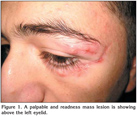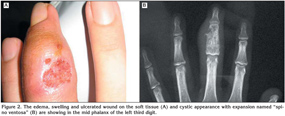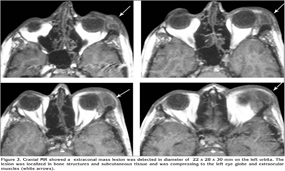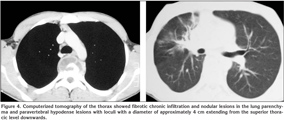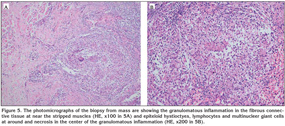Multisistemik tutulum izlenen bir t?berk?loz hastas?
?mer
ARAZ1, ?evket ?ZKAYA2, Hasan G??ER3, Filiz
TA??I4, Sadullah KELE?5,
Deniz Zehra ULUSAN6, ?nal ?AH?N2
1 Rize E?itim ve Ara?t?rma Hastanesi, G???s Hastal?klar? Klini?i, Rize,
2 Rize ?niversitesi T?p Fak?ltesi, G???s Hastal?klar? Anabilim Dal?, Rize,
3 Rize ?niversitesi T?p Fak?ltesi, Patoloji Anabilim Dal?, Rize,
4 Rize E?itim ve Ara?t?rma Hastanesi, Radyoloji Klini?i, Rize,
5 Atat?rk ?niversitesi T?p Fak?ltesi, G?z Hastal?klar? Anabilim Dal?, Erzurum,
6 Rize E?itim ve Ara?t?rma Hastanesi, Mikrobiyoloji Klini?i, Rize.
?ZET
Multisistemik tutulum izlenen bir t?berk?loz hastas?
Birden fazla sistemi tutan t?berk?loz olgular?, s?kl?kla ?ocuklarda ve AIDS gibi imm?n sistemin bask?land??? hastalarda g?r?lmekle birlikte nadiren bildirilmektedir. T?berk?loz pek ?ok hastal??? taklit edebilir ve ?ok farkl? klinik bulgularla kar??m?za ??kabilir. On sekiz ya??nda G?rcistanl? bir erkek hasta, ?ift g?rme, sa? el ???nc? parmakta ?i?lik ve yarayla ba?vurdu. Hastada orbital kemik ve yumu?ak doku t?berk?lozu, t?berk?loz spondilit, t?berk?loz daktilit, deri t?berk?lozu ve akci?er t?berk?lozunu i?eren multisistemik tutulum ile seyreden bir t?berk?loz tan?s? koyduk.
Anahtar Kelimeler: Multisistemik t?berk?loz, ekstrapulmoner t?berk?loz, akci?er t?berk?lozu.
SUMMARY
A case with multisystemic involved of tuberculosis
?mer
ARAZ1, ?evket ?ZKAYA2, Hasan G??ER3, Filiz
TA??I4, Sadullah KELE?5,
Deniz Zehra ULUSAN6, ?nal ?AH?N2
1 Clinic of Chest Diseases, Rize Training and Research Hospital, Rize, Turkey,
2 Department of Chest Diseases, Faculty of Medicine, Rize University, Rize, Turkey,
3 Department of Pathology, Faculty of Medicine, Rize University, Rize, Turkey,
4 Clinic of Radiology, Rize Training and Research Hospital, Rize, Turkey,
5 Department of Ophthalmology, Faculty of Medicine, Ataturk University, Erzurum, Turkey,
6 Clinic of Microbiology, Rize Training and Research Hospital, Rize, Turkey.
Cases of tuberculosis with multisystemic involvement are rarely reported and these are often children and patients with AIDS whose and immune system is suppressed. Tuberculosis can mimic and present with various disorders. A 18-year-old Georgian male patient was admitted to the hospital with double vision, swelling and wound on the 3rd digit of the right hand. We defined the multisystemic tuberculous disease including orbital bone with soft tissue tuberculosis, tuberculosis spondylitis, tuberculosis dactylitis, scrofuloderma and pulmonary tuberculosis in these patient.
Key Words: Multisystemic tuberculosis, extrapulmonary tuberculosis, pulmonary tuberculosis.
Geli? Tarihi/Received: 31/12/2010 - Kabul Edili? Tarihi/Accepted: 04/02/2011
INTRODUCTION
Tuberculosis, which may involve any organ and tissue and may occur in varying clinical presentations, is a public health problem affecting millions of people worldwide. According to the World Health Organization (WHO) report, one third of the whole world population is infected with tuberculosis bacillus (1). Pulmonary tuberculosis is the most common form, although an increase in the frequency of extrapulmonary tuberculosis (EPTB) is being reported recently in individuals with AIDS or those infected with HIV (2). The most common types of extrapulmonary tuberculosis are lymphatic gland, pleural and bone and joint tuberculosis, while soft tissue tuberculosis is the rarest form among all types of tuberculosis (3). We present a case with multisystemic tuberculous disease including orbital bone with soft tissue tuberculosis, tuberculosis spondylitis, tuberculosis dactylitis, scrofuloderma and pulmonary tuberculosis.
CASE REPORT
A 18-year-old Georgian male patient was admitted to the hospital with swelling above the eye, double vision, swelling and wound on the 3rd digit of the right hand. His physical examination revealed a palpable and readness mass lesion above the left eyelid (Figure 1). There was an edema, swelling and ulcerated wound on the soft tissue of the mid phalanx of the left third digit (Figure 2A). There were no relevant findings in the patient's history. A hand radiography showed the cystic appearance with expansion named "spino ventosa" in the bone tissue of the left third digit (Figure 2B). There were no abnormalities in his laboratory values. Sedimentation was 41 mm/hour. The patient underwent PPD test, which was positive. He was HIV-negative. Cranial MR was performed and a extraconal mass lesion was detected in diameter of 22 x 28 x 30 mm on the left orbita. The lesion was extending from the frontal to maxillary region (Figure 3). The lesion was localized in bone structures and subcutaneous tissue and was compressing to the left eye globe and extraocular muscles. CT of the thorax was taken, which showed fibrotic chronic infiltration and nodular lesions in the lung parenchyma and paravertebral hypodense lesions with loculi with a diameter of approximately 4 cm extending from the superior thoracic level downwards (Figure 4). Bronchoscopy revealed the edeumatous narrowing on the right upper bronchus. Acid-fast bacilli was negative by microscopic examination of bronchial lavage fluid. Excisional biopsy was performed from the mass on the patient's left eyelid and the histopathologic analysis showed "caseified granulomatous inflammation"(Figure 5). Based on the clinical, radiologic and pathologic findings, the patient was diagnosed with tuberculosis. The improvement was observed with antituberculosis treatment at lesions and symptoms of patient. The approval of patient and institution were taken to use their records for our study.
DISCUSSION
Extrapulmonary tuberculosis usually occurs due to bacillemia that develops following a primary infection or by endogenous activation. It is reported that EPTB accounts for 15-25% of all patients with tuberculosis. Pulmonary tuberculosis may accompany in 12-75% of patients with EPTB (3,4).
The most frequent forms of extrapulmonary tuberculosis in the USA are lymphatic gland (41.3%), pleura (20.7%), bone and joint (11.2%), miliary (7.4%), genito?riner system (6.6%), central verve system (5.2%) and abdominal (4.2%) forms. The soft tissue tuberculosis is the rarest form among all forms of tuberculosis, with a rate of 1-2% (3).
Signs and symptoms in patients with EPTB may vary by the involved organ. In our case, the cause for presenting to the hospital was a visual disorder. The presence of palpable mass over the eyelid, the MR obtained and it showed a mass lesion in diameter of 22 x 28 x 30 mm on the lateral portion of left orbital structures. It was localized in bone structures and subcutaneous fatty tissue. Also, it was compressing to the eye globe and extraocular muscles. The visual problem of patient was caused from the compress that this mass applied on the eye globe and extraocular muscles.
There was swelling, edema and ulcerated wound on the 3rd digit of right hand. The hand radiography showed destruction, cystic appearance and expansion in midphalanx bone of 3rd digit of right hand. This is a specific finding of tuberculosis infection of short tubular bones of hands and feet and is known as "spina ventosa". This involvement is known as tuberculosis dactylitis.
The ulcerated skin wounds are often a result of bacilli spreading through the skin to the adjacent tissues due to lymph node, bone or joint tuberculosis. This is called "scrofuloderma" (5).
Soft tissue abscess also observed in the paravertebral area, at the anterior of the vertebral corpus, partly invading the corpus. This is defined as the initial finding of the tuberculosis spondilitis (6).
Differently from pulmonary tuberculosis, diagnosis in patients with extrapulmonary tuberculosis is usually made with the histopathologic evaluation. The diagnosis is established after determining granulomatous inflammation including caseification necrosis in the biopsy extracted from the affected region. Improvement obtained after starting the anti-tuberculous treatment also supports the accuracy of diagnosis. A rapid improvement was observed in our patients with antituberculosis treatment at lesions and symptoms of patient.
Cases of tuberculosis with multisystemic involvement, as our patient, are rarely reported and these are often children and patients with AIDS whose and immune system is suppressed (7,8). Our patient did not have any diseases affecting the immune system, nor did he have a history of contact with a tuberculosis patient.
To the best of our knowledge, bone and soft tissue tuberculosis of the orbita is very rare. We did not found the any cases of tuberculosis with multisystemic involvement of orbital bone and soft tissue, and spondylitis, tuberculosis dactylitis, scrofuloderma and pulmonary tuberculosis, in literature.
In conclusion, tuberculosis may be observed in numerous clinical presentations and may simultaneously affect multiple tissues and organs. Pathological outcomes of tuberculosis to each tissue and system should be well-known and early diagnosis should be pursued even in the absence of risk factors. Thus, permanent damages may be prevented with treatment.
CONFLICT of INTEREST
None declared.
REFERENCES
- World Health Organisation: Treatment of Tuberculosis. Guidelines for National Programmes. Geneva, 1997.
- Mehta JB, Dutt A, Harvill L, Mathews KM. Epidemiology of extrapulmonary tuberculosis: a comparative analysis with preAIDS era. Chest 1991; 99: 1134-8. [?zet]
- Iseman MD. A Clinician's Guide to Tuberculosis. Philadelphia: Lippincot Williams and Wilkins, 2000; 145-97.
- Sharma SK, Mohan A. Extrapulmonary tuberculosis. Indian J Med Res 2004; 120: 316-53. [?zet]
- Andrews' Diseases of the Skin. Clinical Dermatology. In: James WD, Berger TG, Elston DM (eds). 10th ed. Canada: Saunders Elsevier, 2006: 333-42.
- Martini M, Adjrad A, Bouddjema A. Tuberculous osteomyelitis. A review of 125 cases. Int Orthop (SICOT) 1986; 10: 201-7. [?zet]
- Narula MK, Chaudhary V, Baruah D, Kathuria M, Anad R. Pictorial assay: orbital tuberculosis. Indian J Radiol Imaging 2010; 20: 6-10. [?zet] [Tam Metin]
- ?ift?i TU, Dursun GD, Apayd?n TSZ, P?t?n ET. Multidrug Resistant Extrapulmonary Tuberculosis Affected 3 Organs. The Archives of Lung 2001; 2: 21-4. [?zet]
Yaz??ma Adresi (Address for Correspondence):
Dr. ?evket ?ZKAYA,
Rize ?niversitesi T?p Fak?ltesi,
G???s Hastal?klar? Anabilim Dal?,
53100 R?ZE -TURKEY
e-mail: ozkayasevket@yahoo.com
